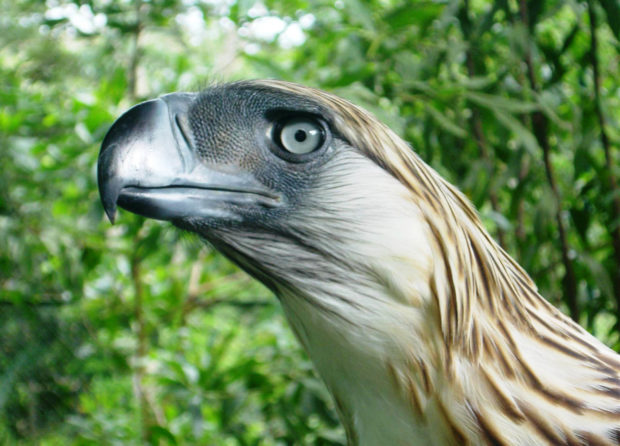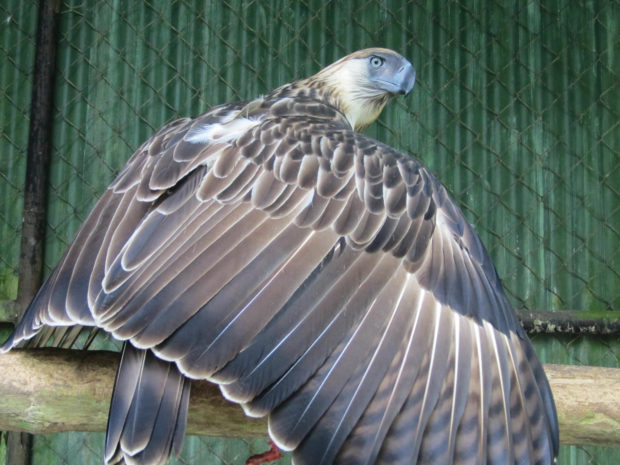Pag-asa: Losing an icon but not hope

CONSERVATION ICON For 28 years, Pag-asa was a celebrity, bringing hope and joy to visitors to the Philippine Eagle Center in Malagos, Davao City. His death serves as an inspiration for the conservation of his critically endangered species. —PHOTO COURTESY OF THE PHILIPPINE EAGLE FOUNDATION
MANILA, Philippines — On Jan. 6, not even a week after the world rang in the new year, Pag-asa died.
Pag-asa, the first Philippine eagle bred and hatched in captivity, was growing weaker at the tail end of the tumultuous 2020, after refusing to eat for weeks, and veterinarians and keepers at the Philippine Eagle Foundation (PEF) were doing their best to keep the raptor alive.
Like other birds, Philippine eagles (Pithecophaga jefferyi) tend to mask their illnesses, often until it’s too late to save them.
At 8:03 p.m. inside the animal hospital, Pag-asa succumbed to trichomoniasis and aspergillosis, diseases both fatal to even the mightiest birds of prey. He would have turned 29 on Jan. 15.
The unexpected loss of an icon brought tears to some staff members of the PEF, which manages the center at the foothills of Mt. Apo in Davao City. Grief soon poured across social media, as news of the passing spread a few days later.
Article continues after this advertisementFor conservationists who have tirelessly worked on protecting the dwindling population of the country’s national bird, Pag-asa’s death is nothing short of tragic. But it is also a reminder of the constant hard work that must be done to save what remains of the critically endangered species.
Article continues after this advertisementDifficult beginnings
In more ways than one, Pag-asa’s arrival was guided by human hands. It strikes a painful irony, considering that human hands, too, had caused the decimation of its species.
The plight of the Philippine eagle, the largest and among the rarest and most powerful birds in the world, first broke into public consciousness in the late ’60s, when logging was at its peak. With one felled tree after another, forests soon vanished, along with the eagles’ home.
As their population plummeted, the government embarked on a captive breeding program in the late ’70s. But without adequate knowledge about the birds, the program resulted in one failed experiment after another.
“The birds tried to kill each other,” recalls Dennis Salvador, PEF executive director, in an interview, noting that they were “very picky, very territorial.”
The foundation, then under a different name, soon found out more about the raptors in its researches. According to its experts, Philippine eagles are extremely slow breeders, with each pair spending two years to rear just a single egg.
A pair also needs some 7,000 hectares of forest cover to survive. And they were also monogamous: a single mate in an entire lifetime.
Hope’s arrival
By 1987, the first fertile egg of a natural pair was produced, but it was no success. The researchers did not know how to handle an eagle’s egg.
Domingo Tadena, now the foundation’s senior conservation breeding biologist, was sent to several raptor centers abroad to study the birds of prey. But when he came back, equipped with the knowledge to start anew, the government gave up on the captive breeding project, Salvador says.
“For over a year, we had no salaries. Whatever money we had, we used it to feed the eagles,” he said. It was then, he said, that the Davao community stepped up to help.
Burdened with logistical issues and threatened by insurgency, the PEF center also moved to its present location: an 8-ha center in Malagos District.
A much-needed breakthrough came a few years later. Pag-asa was laid in November 1991 through a process called “cooperative artificial insemination.” His mother was Philippine eagle Diola; his father, Junior.
The next 56 days were filled with “moments of anxiety,” Salvador recalls. A severe power crisis in Mindanao threatened the egg’s survival inside an artificial incubator. To ensure safety, Tadena and his staff placed the egg inside a water-filled rubber pack, the temperature of which was carefully maintained.
An earthquake also threatened the success of the project.
Live up to his name
With bated breath from his keepers and eagle conservationists, Pag-asa finally hatched on Jan. 15, 1992, but not without help from human hands once more. His arrival, captured in an old film reel, showed the young chick struggling to push out of his shell. Gloved hands tenderly ease him out: the culmination of 14 years of research, hard work and determination against odds.
“It’s like having your own child … Everybody was jumping at the time,” Salvador says. “Sometimes it just takes luck, too.”
He chose the name Pag-asa, particularly for what the eaglet’s hatching symbolized: a hope for the population of the Philippine eagles, and a hope for the country’s rich biodiversity.
For his entire 28 years, Pag-asa stayed in the Philippine Eagle Center, primarily since he has already imprinted on a human: his keeper Eddie Juntilla, his proxy parent and eventual surrogate partner when the bird became sexually mature.

CAPTIVE BREEDING Hatched in 1992, Pag-asa sired his first and only chick, Mabuhay, in February 2013 through artificial insemination. Since Pag-asa, 27 more Philippine eagles have been bred in captivity. —PHOTO COURTESY OF THE PHILIPPINE EAGLE FOUNDATION
Every single day, Pag-asa lived up to his name, bringing hope and joy to visitors in the center and to the general public.
He’s just like any other regular Philippine eagle, with gray eyes and a hazel brown crown, but “he practically knows he is special,” says Jayson Ibañez, the foundation’s director for research and conservation.
Visitors in the center would seek out Pag-asa first. Every Jan. 15, they would celebrate his birth, singing “Happy Hatch Day” songs and blowing birthday candles.
Legacy goes on
“It’s a unique, very sad case, especially since Pag-asa is an icon for conservation,” Ibañez says of his death. “But his legacy remains: the refusal of the people to give up on his species.”
Since Pag-asa, 27 more Philippine eagles have been bred in captivity. Three were released to the wild, but two perished and one had to return to the center. The rest are staying in captivity, meticulously cared for by the center’s staff as the lifeline of their species.
Pag-asa also sired his first and only chick named Mabuhay on Feb. 9, 2013, through artificial insemination.
While the center continues to struggle under the weight of the pandemic, Ibañez says the foundation continues to explore as many options as possible to save the species. These include programs on both natural breeding and artificial insemination, as well as the rescue of wild raptors that are threatened by deforestation and poaching.
The center is currently home to 34 eagles; in the wild, there are an estimated 400 pairs left.
Even in death, Pag-asa will continue to serve as an inspiration and source of awareness, Salvador says. His body has already been preserved and mounted, and will be kept in the center.
“It could have been better if Pag-asa were alive … and be an ambassador for his kind,” he said.
For Salvador, the iconic bird’s passing, even in these difficult and unprecedented times, should not be seen as the death of hope itself.
“Maybe it’s better to say that it is a start of new beginnings, especially in the context of the pandemic: we need to move forward and soldier on.”